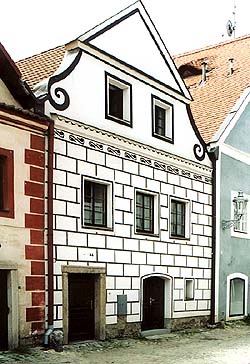Latrán No. 24 – New Town, Pivovarská street
 Location:
Location:
Latrán No. 24 - New Town, Pivovarská street
Description of the Building:
Two story building with a Classicist volute gable and tympanum. The
facade is divided by stucco decoration framing the window. The rear
wing is separated by an exceptionally thick wall. The facade has
letter-shaped sgraffito.
Architectural and Historical Development:
This is a Gothic house but the rear wing was built later, as is
evidenced by the thick wall that separates it. During Renaissance,
the second story vaults were modified and the rear wing probably
built. The front is Classicist.
Significant Architectural Features:
Historically, The house is not very valuable. Only some of the
vaults and the street front with gable are of some value.
History of the House Residents:
In spite of the fact that the house is Gothic, the first records
about its inhabitants are from the end of the sixteenth century. In
1600, Kryštof Täxer was replaced as the owner of the house by
leather cutter Matyáš Loybl who lived here until 1614. Tin-man
Kašpar Salzburger who also worked for the Český Krumlov castle
lived here after him. In 1622, brazier Hans Precht lived in the
house in 1622, and butcher Bartoloměj Steinz from 1627. From 1640,
he was also the owner of the neighboring house Latrán
No. 23. Blacksmith Ambrož Klapeček bought the house in 1644.
Cartwright Wichl lived here from 1657 to 1670. His wife Eva took
over the house after he died. In 1686, blacksmith Jiří Schmidt
moved in, followed five years later by brazier Kristián
Paumgartner. Butcher Jáchym Streintz moved into the house in 1704.
Court cartwright Šebestián Saltzer lived here after him, followed
by servant of the prince Jan Kern who lived in the house from 1714
to 1738. Hatter Václav Perger lived here from 1743, followed by
wig-maker Jan Antonín Schmelzer who lived here from 1761 to 1783.
In 1786, cloth-maker Josef Jopst moved in and his family lived in
the house during the first half of the nineteenth century.
Present Use:
Residential building.

